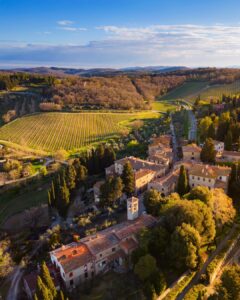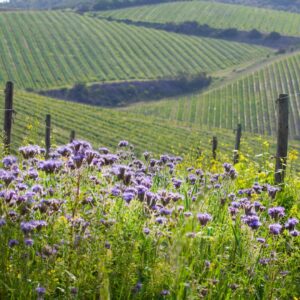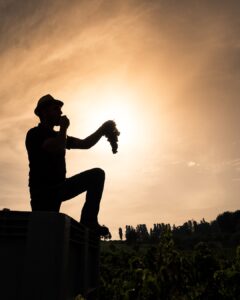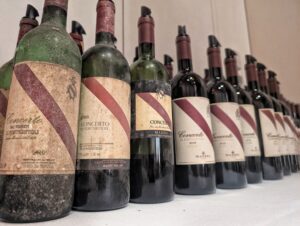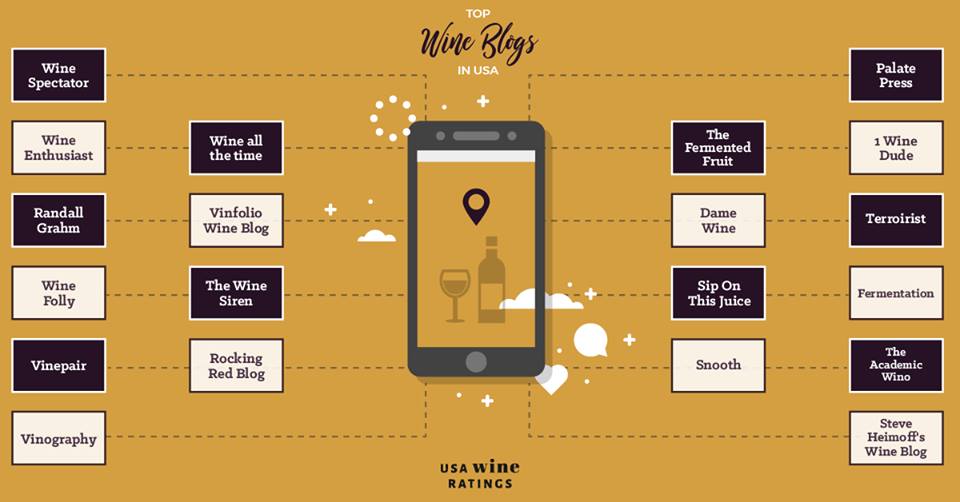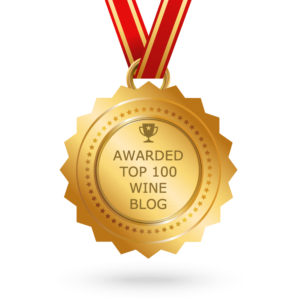It is hard to imagine that Tuscany was once a desperate area stricken by poverty, desolation and despair, as today it is what dreams are made of. The rolling green hills glow in the Tuscan sun, surrounded by forests filled with olive trees and truffles; small enclaves of towns are made up of buildings that exemplify a warm elegance imitated worldwide. Yet after the back-to-back destruction of WWI and WWII and the upheaval of the financial foundations that the Tuscan countryside depended on, it was a tough time for decades. Many families took their losses and abandoned their lands to seize opportunities for financial success in major Italian cities when the future for those in the country looked bleak.
Yet a few key families in this wine region stayed and helped establish it as one of the greatest in the world, such as the Mazzei family, specifically to the famous wine area known as Chianti Classico. But the Mazzei family, throughout many centuries, has been at the foundation of Chianti’s success, going as far back as 1398 when Ser Lapo Mazzei, a Florentine notary, poet and winemaker, in a letter wrote about “Chianti” as a fine wine, one of the best he had tasted and his granddaughter would go on to marry a man who owned an estate in Chianti Classico named after his family’s surname, Fonterutoli; hence the Castello di Fonterutoli estate has been in the Mazzei family since 1435.
Despite knowing the intrinsic outstanding quality potential of Chianti wines, there were many ups and downs due to governmental and financial instability that the Mazzei family had to weather through almost 600 years with a potential threat to wiping out the Tuscan artisanal way of life during the economic devastation of the post World War II era. The 25th-generation Giovanni Mazzei, who runs the Marchesi Mazzei estates with his father and uncle today, talked about those dark times when most locals saw a lost cause when it came to investing in Tuscany. But others saw an excellent opportunity to get out of a sharecropper mindset of focusing on the quantity of various crops to finally focus on achieving the stellar quality of Tuscan wines and, in the case of the Mazzei family, to bring the glory of Chianti Classico to the world.
Hence, a “revolution” was born, according to Giovanni, and part of that revolution was the idea of planting international grapes made famous in France, such as the Cabernet Sauvignon grape variety.
Concerto di Fonterutoli
The Mazzei’s mission to find the extraordinary potential of Chianti Classico did not happen overnight, as that kind of poverty in a region and lack of recognition takes a few generations to overcome. But the Mazzei family is all about building for the future, several decades are nothing compared to their legacy which goes beyond half a millennium. It took a while to get many other producers on board to produce high-quality Chianti, the smaller area of Chianti Classico representing the ultra-premium top tier of the region, while overcoming the detrimental reputation of cheap Chianti initially exported into the U.S. market. Not only did they become a vital part of establishing the illustrious reputation of the mainly Sangiovese-based wine of Chianti Classico but they also were part of the “Super Tuscan” movement by planting Cabernet Sauvignon in the 1970s. In 1981, they released a wine called Concerto di Fonterutolis, a blend of 80% Sangiovese and 20% Cabernet Sauvignon.
After tasting the first vintage, Giovanni’s grandmother noted that the Cabernet Sauvignon and Sangiovese “play together like a concerto,” and at that moment, they were given the name of this auspicious wine.
The work that Mazzei has placed into truly expressing the outstanding sense of place in their Chianti wines has been quite extraordinary, with having the first gravity-fed cellar in the area, employing intense clonal research into using the ideal Sangiovese clones for each parcel and working with 114 plots across seven sub-zones of Chianti Classico illustrating the elegance of the wine as most plots sit at elevations between 720-1,870 feet – cooler temperatures retaining acidity and aromatics. Albeit, some might say, they did too good of a job as there was such a demand in the premium wine market for their Chianti wines based on Sangiovese that they stopped making the Concerto di Fonterutoli.
Just west of Chianti Classico is the wine area of Bolgheri and it became the place known as the center for “Super Tuscans” as there wasn’t a famous historical wine such as Chianti that would take away from the focus of these experimental wines that blended the glorious, traditional Sangiovese grape with Bordeaux grape varieties such as Merlot and Cabernet. So, for a time, it made sense that the Mazzei family focused on the grape variety that the family has been heralding for 600 years – Sangiovese. They stopped making the Concerto di Fonterutoli after the 1994 vintage.
Honoring A Matriarch
The 2011 vintage marked the 30th anniversary of the first vintage of Concerto di Fonterutoli, so after 17 years, the Mazzei family released a tiny production, around 1,000 bottles of the 2011 Concerto di Fonterutoli, allowing the Sangiovese and Cabernet Sauvignon to play together in a beautiful concerto one more time in honor of the great matriarch of the family. To their surprise, there was a huge customer demand as the wine was a rare and distinctive expression of these varieties compared to what was being made in Bolgheri, and they brought back the wine permanently starting with the 2013 vintage; today, they celebrate releasing the 40th anniversary of the 2021.
Concerto di Fonterutoli represents a fantastic experiment between tradition and innovation with the blend of these two grapes and a breathtaking expression of two special parcels. The Sangiovese grapes come from some of their best parcels in the lower part of the Fonterutoli estate with rocky, chalky soil and the Cabernet comes from a tiny plot surrounded by an oak forest that has calcareous rocks, with both sitting around 1,150 feet of elevation; showcasing the individual purity and finesse of each variety that share a special bond of both having a affinity for terroir expression.
All those centuries ago, when that remarkable Florentine Renaissance man, Ser Lapo Mazzei, noted the greatness of the “Chianti” wine back in the late 1300s, he could have never imagined all the upheavals that would happen to his precious world, considered to be the center of culture during that time. And he certainly couldn’t imagine that future generations of his family would survive the darkest of times and be a part of elevating the region to worldwide acclaim.
Or maybe, just maybe, he did know, as he was, after all, a Renaissance man who foretold the glory of Chianti 600 years before it was recognized.
Link to original Forbes article: https://www.forbes.com/sites/cathrinetodd/2024/10/20/special-italian-wine-celebrates-comeback-after-great-customer-demand/
Vertical of Mazzei Concerto di Fonterutoli from 1981 to 2021:
1981 Mazzei Concerto di Fonterutoli, Tuscany, Italy: 80% Sangiovese and 20% Cabernet Sauvignon. Garnet color with a complex nose of tarragon and stewed black cherries with a hint of dried oregano and lots of acidity with an ultra-fine texture with electric tart cranberries on the palate with a long aromatic finish with a lingering note of star anise.
1988 Mazzei Concerto di Fonterutoli, Tuscany, Italy: 80% Sangiovese and 20% Cabernet Sauvignon. Deeper ruby color than the 1981 with a garnet rim with a rich nose with aromas of cocoa dust, a whiff of espresso and crushed rocks with a plush body and silky texture with blackberry fruit intermixed with baking spices.
1994 Mazzei Concerto di Fonterutoli, Tuscany, Italy: 80% Sangiovese and 20% Cabernet Sauvignon. An overall finesse to this beauty with a texture like fine lace with a multifaceted bouquet of rose petals and tar with juicy cassis flavors along the very long finish.
2013 Mazzei Concerto di Fonterutoli, Tuscany, Italy: 80% Sangiovese and 20% Cabernet Sauvignon. Stunning, pure ruby color that foreshadowed the incredible purity of fruit on the palate with fresh blueberries and warm raspberries with an underlying minerality that brings this wine to another level of elegance.
2015 Mazzei Concerto di Fonterutoli, Tuscany, Italy: 80% Sangiovese and 20% Cabernet Sauvignon. The round texture with supple tannins, like ribbons of silk caressing the palate, is impressive, with fresh tobacco notes that balance the generous fruit.
2016 Mazzei Concerto di Fonterutoli, Tuscany, Italy: 80% Sangiovese and 20% Cabernet Sauvignon. An intriguing nose with smoldering earth and graphite that has crunchy blackberry and red currant fruit on the palate with the enticing aroma of a lit cigar ruminating in one’s head for several seconds after the finish.
2018 Mazzei Concerto di Fonterutoli, Tuscany, Italy: 80% Sangiovese and 20% Cabernet Sauvignon. Roasted coffee beans with dark chocolate make a delicious start enhanced by flavors of cherry tart on the finish with lingering notes of dried herbs and a smoky minerality.
2019 Mazzei Concerto di Fonterutoli, Tuscany, Italy: 80% Sangiovese and 20% Cabernet Sauvignon. A nose that jolts one into the terroir of the vineyards with notes of tree bark, truffles and forest floor with a lovely richness on the mid-palate with delightful flavors of dark cherry scone and boysenberry cobbler with an exquisite texture that has an extraordinarily long finish that goes on and on and on.
2020 Mazzei Concerto di Fonterutoli, Tuscany, Italy: 80% Sangiovese and 20% Cabernet Sauvignon. A pretty nose of wildflowers and a breathtaking purity of raspberry fruit with an overall harmonious quality with hints of wet river stones with a bright acidity and darker brambly fruit on the palate that finishes with real precision.
2021 Mazzei Concerto di Fonterutoli, Tuscany, Italy: 80% Sangiovese and 20% Cabernet Sauvignon. Enchanting rose oil and cinnamon stick aromas lead into a velvety texture with red cherry compote intermixed with a very elegant chalky minerality note with an expressive prolonged finish with an impressive delineation of the aromas and flavors.

